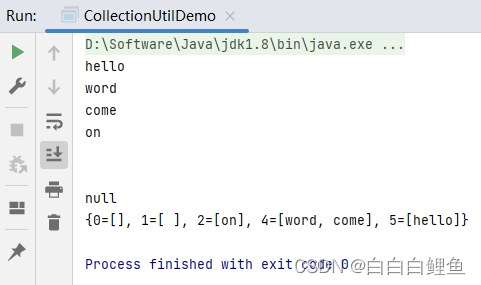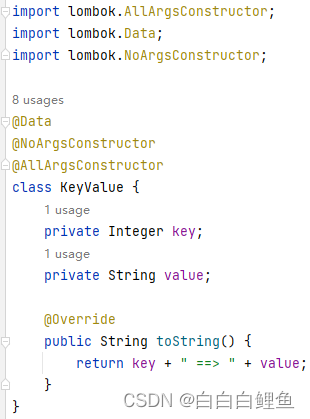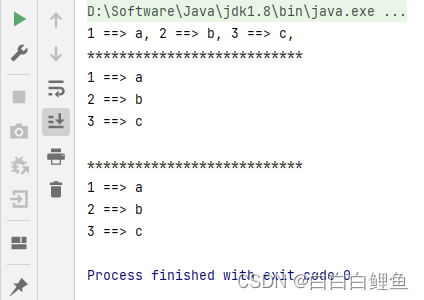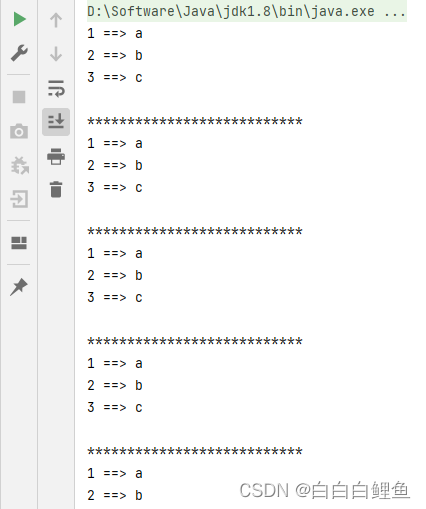最近遇到了一个场景是,要将从数据库中查出的List
①、当是list
比如要实现将从数据库中查出的字符串按照长度进行分组,并返回给前端
(这里我就往list中插入几个数据,进行模拟)
List list = new ArrayList<>(); list.add("hello"); list.add("word"); list.add("come"); list.add("on"); list.add(""); list.add(" "); list.add(null); for(String s:list){ System.out.println(s); } Map> ans = new HashMap<>(); for(String str: list) { if(str != null) { //增加非空判断 List sub = ans.get(str.length()); if (sub == null) { sub = new ArrayList<>(); ans.put(str.length(), sub); } sub.add(str); } } System.out.println(ans); 
当然代码还可以优化一下:(这样的代码简洁性确实提高了,不过代码的可读性不高,实际场景下也不太会这样写)。
for(String str: list) { if(str != null) { //增加非空判断 List sub = ans.computeIfAbsent(str.length(), k -> new ArrayList<>()); sub.add(str); }} 不过还是解释一下这段代码:
computeIfAbsent(K key, Function mappingFunction) 是一个Map的方法,用于计算Map中的Value。 如果Key已经存在,则直接返回对应的Value;如果Key不存在,则使用给定的mappingFunction计算Value并添加到Map中,最后返回Value。 这样做的好处是可以避免手动检查Key是否存在并添加Value,从而简化代码。 因此,List
sub = ans.computeIfAbsent(str.length(), k -> new ArrayList<>()); 的意思是: 如果Map中已经包含了指定长度的字符串列表,则直接取出这个列表赋值给sub; 否则就新建一个空列表并把它赋值给sub,并将这个空列表添加到Map中去。
②、当是list
比如要实现将从数据库中查出的对象list,取对象list中的值,并返回给前端
针对这种情况,先创建一个对象

//创建一个listList list33 = new ArrayList<>();list33.add(new KeyValue(1, "a"));list33.add(new KeyValue(2, "b"));list33.add(new KeyValue(3, "c"));//打印出listfor(KeyValue item1:list33) { System.out.print(item1+", ");}System.out.println("\n***************************"); //换行输出// 遍历Map keyValueMap = new HashMap<>();for (KeyValue keyValue : list33) { keyValueMap.put(keyValue.getKey(), keyValue.getValue());}keyValueMap.forEach((k, v) -> System.out.println(k + " ==> " + v));System.out.println("\n***************************"); //换行输出// Java8 StreamMap map = list33.stream().collect(Collectors.toMap(KeyValue::getKey, KeyValue::getValue));map.forEach((k, v) -> System.out.println(k + " ==> " + v)); 
还可有这种思路写法:(当时这个对象属性太多,实际情况还是不要这样写),写的思路可以简述为:(这其实都可以归到 ListList转换成一个List。具体来说,首先对于列表中的每个元素,也就是一个Map,将其所有的键值对取出来。然后对于每个键值对,即Map.Entry,只取它的值,也就是entry.getValue(),并加入valueList中。最终得到的valueList即是所有字符串值的列表。
// 从数据库ensure表中读取数据 List userList = staffMapper.getAllStaff(year, month); log.info("数据为:\n{}", userList); List> salaryList = new ArrayList<>(); for (Salary salary : userList) { Map salaryMap = new LinkedHashMap<>(); salaryMap.put("userName", salary.getUserName()); salaryMap.put("firstDepart", salary.getFirstDepart()); salaryMap.put("secondDepart", salary.getSecondDepart()); salaryMap.put("post", salary.getPost()); salaryMap.put("idNumber", salary.getIdNumber()); salaryMap.put("cardNumber", salary.getCardNumber()); salaryMap.put("basicSalary", salary.getBasicSalary()); salaryMap.put("rankSalary", salary.getRankSalary()); salaryMap.put("performSalary", salary.getPerformSalary()); salaryMap.put("subsidy", salary.getSubsidy()); salaryMap.put("overtimeDay", salary.getOvertimeDay()); salaryMap.put("subsidyMeal", salary.getSubsidyMeal()); salaryMap.put("fullDay", salary.getFullDay()); salaryMap.put("compassLeave", salary.getCompassLeave()); salaryMap.put("sickLeave", salary.getSickLeave()); salaryMap.put("actualDay", salary.getActualDay()); salaryMap.put("basePay", salary.getBasePay()); salaryMap.put("rankPay", salary.getRankPay()); salaryMap.put("performPay", salary.getPerformPay()); salaryMap.put("performSubsidy", salary.getPerformSubsidy()); salaryMap.put("performDeduct", salary.getPerformDeduct()); salaryMap.put("illegalDeduct", salary.getIllegalDeduct()); salaryMap.put("confidSubsidy", salary.getConfidSubsidy()); salaryMap.put("bonus", salary.getBonus()); salaryMap.put("fine", salary.getFine()); salaryMap.put("totalPay", salary.getTotalPay()); salaryMap.put("retire", salary.getRetire()); salaryMap.put("medicalLive", salary.getMedicalLive()); salaryMap.put("unemploy", salary.getUnemploy()); salaryMap.put("housing", salary.getHousing()); salaryMap.put("childrenDeduct", salary.getChildrenDeduct()); salaryMap.put("educatDeduct", salary.getEducatDeduct()); salaryMap.put("housingDeduct", salary.getHousingDeduct()); salaryMap.put("rentalDeduct", salary.getRentalDeduct()); salaryMap.put("supportDeduct", salary.getSupportDeduct()); salaryMap.put("careDeduct", salary.getCareDeduct()); salaryMap.put("personalTax", salary.getPersonalTax()); salaryMap.put("actualPay", salary.getActualPay()); salaryMap.put("socialUnitpart", salary.getSocialUnitpart()); salaryMap.put("amonthlySalary", salary.getAmonthlySalary()); salaryMap.put("achieveBonus", salary.getAchieveBonus()); salaryMap.put("status", Integer.valueOf(103).equals(salary.getStatus()) ? "已确认" : "未确认"); salaryMap.put("evidence", salary.getEvidence()); salaryList.add(salaryMap); } //取出map键值对中的value值 List valueList = new ArrayList<>(); for (Map salaryMap : salaryList) { Set> entrySet = salaryMap.entrySet(); for (Map.Entry entry : entrySet) { valueList.add(entry.getValue()); } } Map map33 = new HashMap<>();map33.put(1, "a");map33.put(2, "b");map33.put(3, "c");// key 转 ListList keyList = new ArrayList<>(map33.keySet());List keyList2 = map33.keySet().stream().collect(Collectors.toList());keyList.forEach(System.out::println);keyList2.forEach(System.out::println);// value 转 ListList valueList = new ArrayList<>(map33.values());List valueList2 = map33.values().stream().collect(Collectors.toList());valueList.forEach(System.out::println);valueList2.forEach(System.out::println);// Iterator转ListList keyValueList = new ArrayList<>();Iterator it = map33.keySet().iterator();while (it.hasNext()) { Integer k = (Integer) it.next(); keyValueList.add(new KeyValue(k, map33.get(k)));}keyValueList.forEach(System.out::println);// Java8 StreamList list = map33.entrySet().stream().map(c -> new KeyValue(c.getKey(), c.getValue())) .collect(Collectors.toList());list.forEach(System.out::println); 如果对map遍历还不是很熟悉的小伙伴可以再复习一下map遍历
Map map = new HashMap<>();map.put(1, "a");map.put(2, "b");map.put(3, "c");// Map.keySet遍历for (Integer k : map.keySet()) { System.out.println(k + " ==> " + map.get(k));}System.out.println("\n***************************"); //换行输出map.keySet().forEach(k -> System.out.println(k + " ==> " + map.get(k)));System.out.println("\n***************************"); //换行输出// Map.entrySet遍历,推荐大容量时使用for (Map.Entry entry : map.entrySet()) { System.out.println(entry.getKey() + " ==> " + entry.getValue());}System.out.println("\n***************************"); //换行输出map.forEach((key, value) -> System.out.println(key + " ==> " + value));System.out.println("\n***************************"); //换行输出// Iterator遍历Iterator> it = map.entrySet().iterator();while (it.hasNext()) { Map.Entry entry = it.next(); System.out.println(entry.getKey() + " ==> " + entry.getValue());}System.out.println("\n***************************"); //换行输出map.entrySet().iterator() .forEachRemaining(entry -> System.out.println(entry.getKey() + " ==> " + entry.getValue()));System.out.println("\n***************************"); //换行输出// 遍历valuesfor (String v : map.values()) { System.out.println(v);}System.out.println("\n***************************"); //换行输出map.values().forEach(System.out::println);System.out.println("\n***************************"); //换行输出// Java8 Lambdamap.forEach((k, v) -> System.out.println(k + " ==> " + v)); 
来源地址:https://blog.csdn.net/weixin_49171365/article/details/130928401




